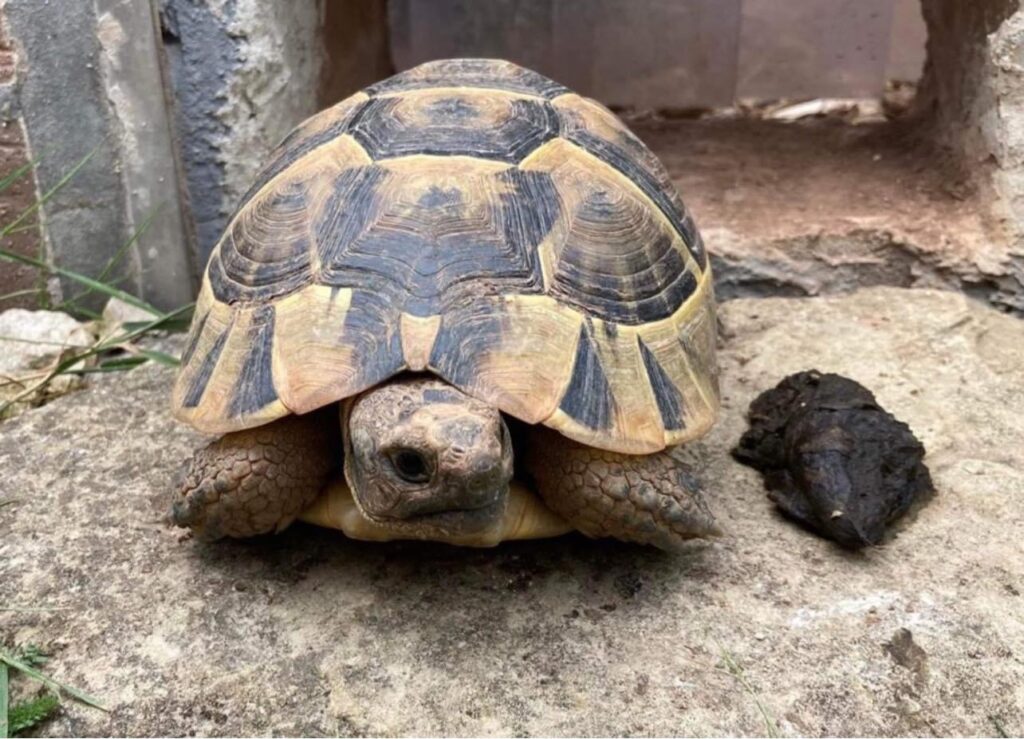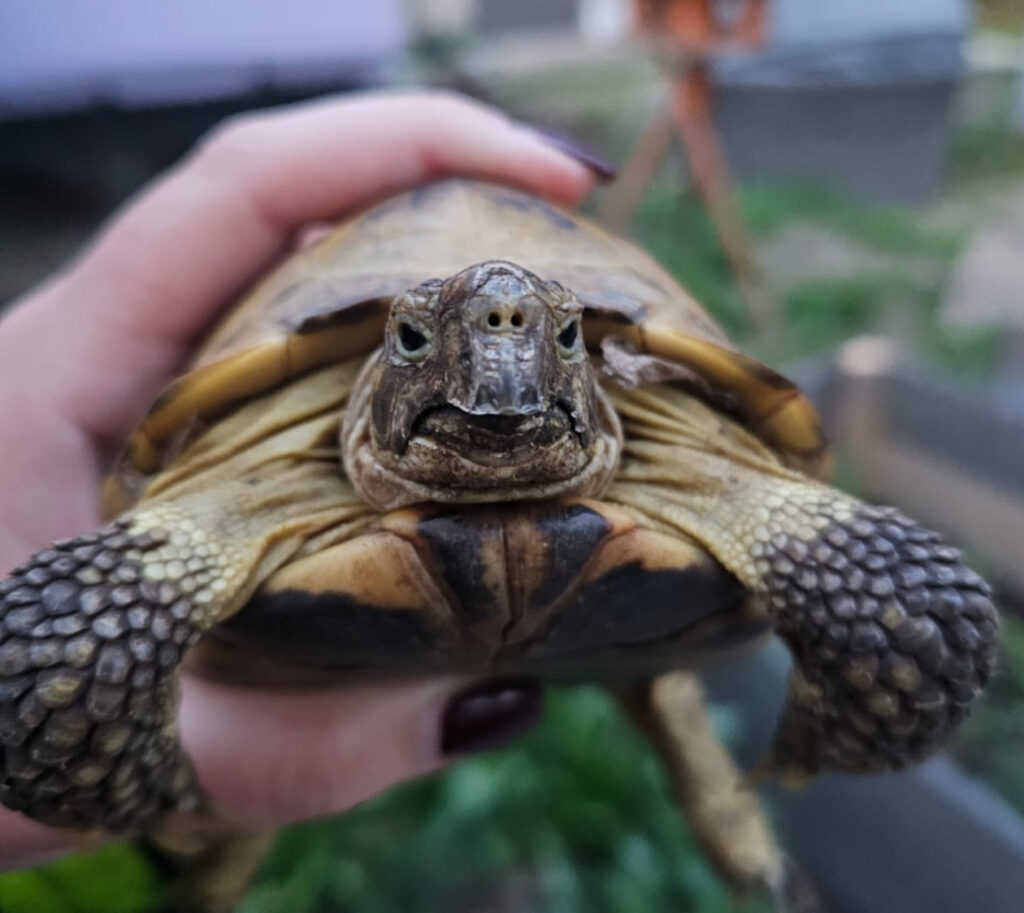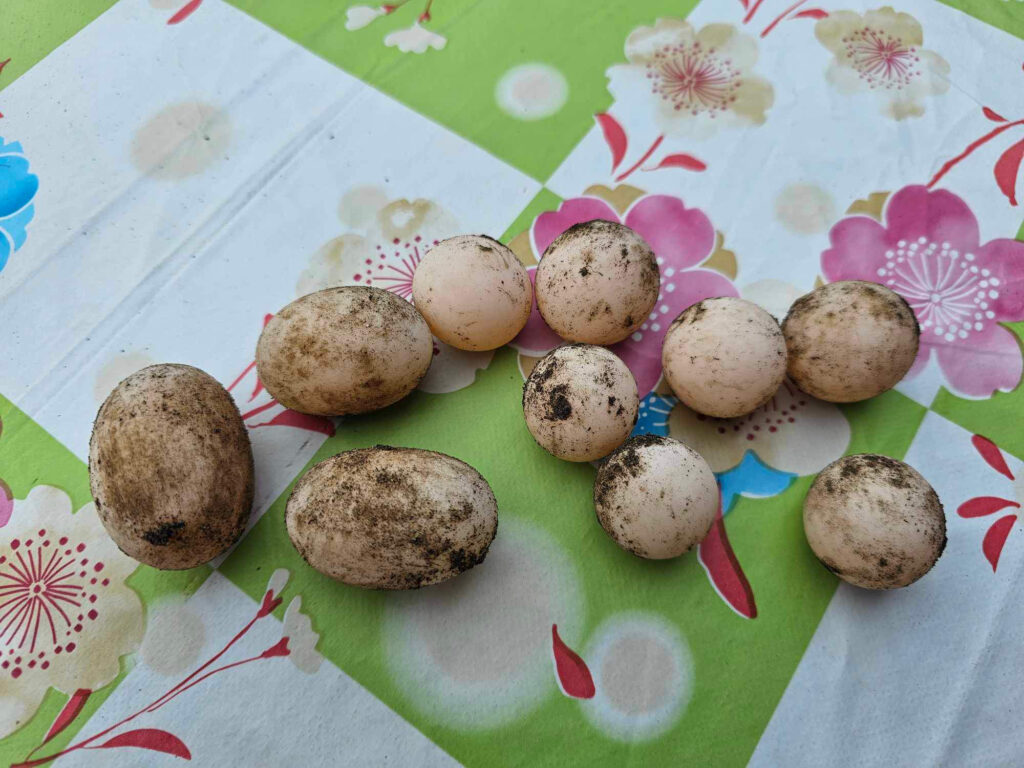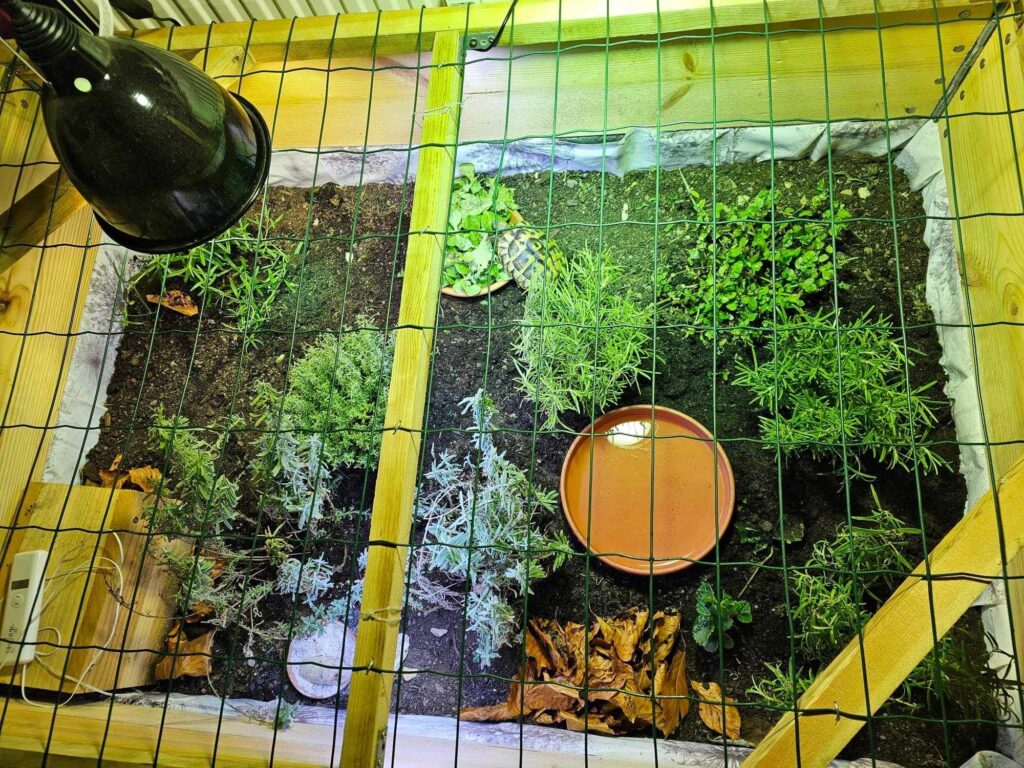Common Diseases in European Tortoises
The most common diseases in European tortoises can vary depending on their environment, care conditions, and individual factors. It’s important to remember that European tortoises are wild animals that conceal health issues as long as possible to avoid becoming prey. This means you should closely monitor your tortoises to detect and address any behavioural changes early on.
Here are some of the most common diseases that can occur in European tortoises:
- Respiratory Diseases: Respiratory infections, such as mycoplasma rhinitis or herpesvirus infections, are common issues in European tortoises. These infections can lead to symptoms like wheezing, nasal discharge, breathing difficulties, pneumonia, and eye infections. Additionally, irritations of the respiratory tract can occur from overly dry, dusty, or mouldy substrates. Drafts and cold temperatures can also cause colds and pneumonia.
- Digestive Problems: Digestive disorders such as constipation, diarrhoea, or intestinal blockage can occur in European tortoises. These issues can be caused by an unbalanced diet, the accidental ingestion of unsuitable substrates (such as bark mulch or wood chips), infections, parasites or other factors.
- Parasite Infestations: European tortoises can be affected by various parasites, such as worms or mites. A parasitic infestation can lead to weight loss, loss of appetite, weakness, and other symptoms. During hibernation, a parasite infestation can be fatal, so stool samples should be regularly examined for intestinal parasites several times a year.
- Shell Rot: This condition is characterised by soft, decaying areas on the shell and is usually caused by fungal or bacterial infections. It often results from poor hygiene or environmental conditions.
- Further Shell Problems: European tortoises can develop various shell issues, including cracks, abscesses, necrosis, or fungal infections. These problems can result from injuries, improper housing, or poor hygiene. Shell deformations, such as the development of lumps, can also be caused by improper care. Such deformities often come with many other health problems, and tortoises may suffer from these handicaps for life.
- Nutrient and Vitamin Deficiencies: An inadequate diet can lead to deficiencies in essential vitamins and minerals, causing various health issues in European tortoises. Tortoises should always have access to calcium in the form of algae lime and sepia. Their diet should be species-appropriate, consisting of wild herbs.
- Egg-Laying Problems: If a female tortoise is unable to lay her eggs in a timely manner, she may experience egg-binding (dystocia). The causes can be varied, including both organic and external factors. For example, females that are constantly with males may not have adequate rest, leading to increasingly difficult egg-laying. Cold weather, calcium deficiency, and cold housing can also contribute to this issue. Symptoms of egg-binding include unsuccessful attempts to lay eggs, hyperactivity, and subsequent lethargy. Suspected egg-binding is an emergency and should be addressed immediately by a reptile veterinarian.
- Metabolic Bone Disease (MBD): Caused by a lack of calcium or UVB light, MBD leads to weakened bones and shell deformities. It is preventable through proper diet and UVB exposure
- Kidney Stones: These can form due to dietary imbalances and lead to discomfort or urinary issues.
It is crucial that European tortoises are regularly examined by a reptile veterinarian to detect potential diseases early and take appropriate measures. A pre-hibernation check-up should be performed in September before the onset of cold weather. Proper care and nutrition are key to minimising the risk of diseases in European tortoises.
Intestinal Parasites
Stool Examination: It is essential to have a stool examination for intestinal parasites conducted regularly, ideally several times a year, by a reptile veterinarian or specialised laboratories that can analyse the samples sent to them.
It is recommended to begin deworming even at the first signs of a mild infestation. Keep in mind that after completing a deworming treatment, the tortoises should be kept at high summer temperatures for at least 6-8 weeks to ensure that the dead worms and deworming medication are fully excreted before hibernation.
It is advisable to collect stool samples over a period of 3 days, preferably over a weekend, and to take the samples directly to the vet on Monday or send them by priority mail. For groups of tortoises, collect pooled samples, while for individually housed tortoises that have had no contact with others, collect samples over several days for a single test.
A warm bath can help relax the tortoises and stimulate digestion.
The samples should be kept in a tightly sealed stool tube with a drop of water in the refrigerator until they are sent or delivered to the vet. If there is no reptile veterinarian nearby, the stool sample can be moistened with a drop of water and sent in a padded envelope to a laboratory. Results, including dosage instructions for medications, can then be obtained via email or mail and the medication can be prescribed by any veterinarian (dosage depends on weight).
Some veterinarians experienced with tortoises are also capable of examining the samples themselves.
During and after the deworming phase, maintaining good hygiene is crucial. Always provide fresh, clean water in bathing dishes that have been washed with hot water and a mild environmentally friendly detergent and then dried in the sun to help limit fluid loss. Stool should be collected daily to prevent re-infestation. At favourite spots, such as in burrows and sleeping boxes, replace the substrate superficially after treatment. A follow-up examination 2 weeks after the treatment is recommended. If parasites are still present, another round of deworming may be necessary.
After deworming, supporting the recovery of essential gut flora can be done in consultation with the vet, for example, by adding probiotics and prebiotics to the diet.

Beak Overgrowth
In tortoises, natural beak wear generally occurs through appropriate feeding and typically does not require artificial trimming. However, if a tortoise has been subjected to an inadequate diet for years, often lacking fibre-rich wild plants, cuttlefish, or UV-B, minor beak overgrowth can sometimes be addressed by switching to a proper diet and providing UV-B light, cuttlefish, and algae calcium.
If there is significant beak overgrowth, known as a „parrot beak,“ professional trimming by a reptile veterinarian is necessary. This procedure is often carried out in multiple stages, as such beaks are frequently brittle and need to be strengthened first through adequate calcium and UV-B exposure. Beaks that are already partially broken also require examination by a reptile vet to prevent further breakage.
Overbites and underbites of the jaw should also be thoroughly assessed, especially if there are problems with tearing food plants. Tortoises with anomalies of the naso-labial fold or palate should be seen by a reptile veterinarian as hatchlings and require particularly attentive monitoring.
The examination and treatment of beak anomalies in tortoises require a comprehensive approach that considers not only the external appearance but also the underlying causes. It is crucial to avoid unprofessional attempts at filing or trimming.


Egg Binding (Dystocia)
Egg binding, also known as dystocia, is a critical condition that can occur in female animals such as reptiles, birds, or some vertebrates. It happens when a female has difficulty laying her eggs naturally, due to either a lack of suitable laying sites or anatomical obstructions.
A key indicator of egg binding is the altered behaviour of the female. It starts with restless activities in the sand or substrate, where the animal digs trial pits but does not lay any eggs. This behaviour is accompanied by increased agitation, and the animal gradually stops eating. Often, this is followed by a state of lethargy. Such behaviour is an alarming sign of potential egg binding.
Diagnosis of egg binding can be aided by imaging techniques such as X-rays, which reveal the presence of eggs in the abdomen of the affected animal. In some cases, administering oxytocin, a hormone that stimulates uterine contractions, under veterinary supervision, may help the female lay the eggs naturally without the need for invasive surgery. However, if any of the eggs are in an unfavourable position, such as being lodged sideways or fused and blocking the passage for other eggs, surgical removal of the eggs is often unavoidable.
This step is crucial as untreated egg binding can lead to serious health consequences for the female, including potential death. It is important to note that egg binding can occur not only in females kept in groups but also in solitary individuals, underscoring the importance of early detection and appropriate veterinary intervention. Care and management of affected animals therefore require special attention to minimise the occurrence and impact of egg bin

Mycoplasma Infections in European Tortoises
Mycoplasma are a group of bacteria that lack a cell wall, making them the smallest known free-living organisms. They can cause various diseases in both animals and humans.
In European tortoises, Mycoplasma can lead to a respiratory infection known as Mycoplasma rhinitis. This infection may result in symptoms such as nasal discharge, breathing difficulties, eye infections, and general weakness. Pneumonia and eye inflammation may also occur. In some cases, the infection can become chronic, leading to severe health issues.
Mycoplasma infections are particularly dangerous for European tortoises because they can weaken the immune system, making the animals more susceptible to other diseases. The infection can easily spread to other tortoises, especially if they are in close contact.
Regular veterinary check-ups are crucial to detect and treat potential infections early. Good hygiene and proper husbandry practices can help reduce the risk of Mycoplasma infections. Before introducing new tortoises to a group, it is important to adhere to a proper quarantine period to minimise the risk of disease transmission. Multiple tests for herpes and Mycoplasma should also be conducted. (See the section on Quarantine below.)
Several Mycoplasma strains have been identified in European tortoises, including:
- Mycoplasma agassizii:
This is one of the most well-known and widespread strains affecting European tortoises. It causes Mycoplasma rhinitis, a respiratory infection that can lead to symptoms such as nasal discharge, breathing difficulties, and eye infections. - Mycoplasma testudineum:
This strain has also been identified in European tortoises and can cause symptoms similar to Mycoplasma rhinitis. - Mycoplasma dromedarii:
Originally identified in dromedaries, this strain can also affect European tortoises, leading to respiratory infections with symptoms similar to those of Mycoplasma rhinitis.
It is important to note that Mycoplasma infections in European tortoises may be caused by a combination of different strains. Accurate identification of the involved strains requires specialized laboratory tests and investigations.
Treating Mycoplasma infections in European tortoises can be challenging, as these bacteria are often resistant to many antibiotics. Early diagnosis, appropriate treatment, and good hygiene practices are crucial to preventing the spread of Mycoplasma infections and maintaining the health of the tortoises.
Herpesviruses in European Tortoises
Herpesviruses can cause a disease known as Herpesvirus infection in European tortoises, which can have severe and sometimes fatal consequences. Often, affected tortoises may need to be euthanised by a reptile veterinarian.
The herpesvirus in European tortoises can produce a range of symptoms, including respiratory distress, nasal discharge, eye infections, loss of appetite, weight loss, lethargy, and skin changes. In some cases, neurological symptoms such as coordination disorders or paralysis may also occur.
The herpesvirus infection can spread rapidly and infect other tortoises in the vicinity. The virus is known to be transmitted through direct contact, droplet infection, or contaminated environments.
There is no specific treatment for herpesvirus infection in European tortoises. The best approach is to prevent the spread of the infection by isolating infected animals away from healthy ones and maintaining good hygiene practices. Early diagnosis and treatment of other underlying illnesses or immune deficiencies can also help minimise the impact of the infection.
It is crucial for European tortoises to be regularly examined by a reptile veterinarian to detect potential infections early and to take appropriate measures to prevent the spread of this dangerous disease. Before introducing new tortoises to an existing group, it is essential to adhere to a proper quarantine period to minimise the risk of disease transmission. Additionally, several tests for herpes and Mycoplasma should be conducted. (See the Quarantine section below.)
Several herpesvirus strains have been identified in European tortoises. Here are some of the most common herpesvirus strains found in European tortoises:
- European Tortoise Herpesvirus (ETHV):
This strain is specific to European tortoises and can cause severe diseases. ETHV is believed to be responsible for the so-called „tortoise herpesvirus syndrome,“ which can lead to respiratory problems, skin changes, neurological symptoms, and even death. - Testudo Herpesvirus 1 (TeHV-1):
This strain has been identified in European tortoises and can cause symptoms similar to ETHV. It is thought that TeHV-1 is closely related to ETHV and may be a variant of the same virus.
It is important to note that herpesvirus infections in European tortoises can have serious and potentially fatal effects. Early diagnosis, appropriate treatment, and good hygiene practices are essential to preventing the spread of herpesvirus infections and maintaining the health of non-infected tortoises.
Pre-Hibernation Check-Up with a Reptile Veterinarian
To prevent complications, reptile veterinarians recommend conducting a thorough health check at least six weeks before hibernation. This check-up should include a general clinical examination as well as a stool analysis. If treatment for parasites is needed, hibernation should only commence six weeks after the last administration of medications. This delay is necessary because at low temperatures, medications are not metabolised and excreted properly in the body.
A complete health check should also include an X-ray examination to detect conditions such as respiratory diseases, retained eggs, or bladder stones. For animals weighing more than 120 grams, a blood test is advisable. This helps to better assess the condition of the animal’s organs through liver and kidney values as well as electrolytes.
Quarantine of European Tortoises
Some diseases in tortoises are not immediately visible. Animals can appear healthy, active, and fit, yet many carry dangerous bacteria and viruses that can quickly threaten and even wipe out entire tortoise populations. Therefore, it is crucial to place new tortoises in quarantine before introducing them to existing animals, and to have them tested. During quarantine, the new tortoises should be treated as if they are infected to avoid posing any risk to the existing animals. The established animals are always cared for first, followed by the quarantined animals. Hands should be thoroughly washed and disinfected, and tools, equipment, and accessories should be marked and stored separately. Cleaning supplies for food and water dishes, for instance, should be designated for use only in the quarantine area. Additionally, a change of shoes and gloves should occur before handling the quarantine area.
Food plants should not be transferred from the quarantine area to other animals due to the risk of infection. Reptile veterinarians typically recommend quarantine durations of 1 to 2 years. During this period, all animals to be introduced, including the existing ones, should undergo multiple tests for herpes and mycoplasma, and, if necessary, for rana virus and virus X, in consultation with the treating reptile veterinarian. If all these tests are negative and stool tests for intestinal parasites are also satisfactory, the animals can be introduced to each other.
Here are some steps to follow during the ideal quarantine period of 1 to 2 years:
- Separation of the New Tortoise:
The new tortoise should be housed in a separate enclosure and basking area that is physically distant from the existing tortoises. This prevents direct contact and potential transmission of pathogens. Shared hibernation should not occur with quarantine animals. - Veterinary Examination:
The new tortoise should be thoroughly examined by a reptile veterinarian to identify any potential diseases or parasites. This is crucial for excluding mycoplasma infections or other contagious diseases like herpes. This examination should be done for all animals to be introduced, provided that negative test results are not yet available. - Observation of the New Tortoise:
During the quarantine period, the new tortoise should be regularly observed for signs of illness or parasites. Look for changes in behaviour, loss of appetite, weight loss, breathing difficulties, or signs of infection such as nasal discharge, respiratory noises, or eye and ear infections. Stool should be routinely tested for intestinal parasites several times a year. - Hygiene:
Maintaining good hygiene practices during the quarantine period is essential. This includes regular handwashing before and after handling the tortoises, disinfecting, using separate equipment for the new tortoise, and regularly cleaning the quarantine enclosure. When entering the enclosures, changing shoes or using shoe covers is necessary to prevent transferring pathogens from one enclosure to another.
The duration of the quarantine period may vary depending on the situation, but many reptile veterinarians recommend a minimum of 8 weeks, with two tests for herpes and mycoplasma, to ensure the new tortoise is healthy and does not transmit diseases to the existing tortoises. Ideally, a quarantine period of 1 to 2 years is maintained, with tests for herpes and mycoplasma (and possibly rana virus and virus X) conducted immediately after waking from hibernation. These tests are considered particularly significant.
